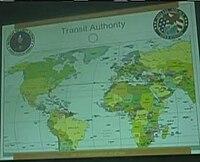Fairview (surveillance program)
 National Security Agency surveillance |
|---|
 |
Fairview is a secret program under which the
In 2010, the NSA had access to these AT&T facilities:[2]
- 8 internet peering points
- 26 VoIProuter facilities
- 1 VoIP hub router facility (with 30 planned)
- 9 submarine cable landing points (with 7 planned)
- 16 4ESScircuit switching stations
Except for the VoIP facilities, most are along U.S. borders.
In 2011, NSA spent $188.9 million on the program, which was twice as much as on its second-largest program, STORMBREW.[1]
In 2013, whistleblower Edward Snowden revealed that the NSA was harvesting the telephone metadata and text messages from over a billion subscribers in China; no precise program name was reported at the time.[3]
Several weeks later, Glenn Greenwald wrote in The Guardian about FAIRVIEW: "The NSA partners with a large US telecommunications company" that "partners with telecoms in the foreign countries, [which] then allow the US company access to those countries' telecommunications systems, and that access is then exploited to direct traffic to the NSA's repositories."[4]
Documents provided by Snowden said the NSA had collected 2.3 billion separate pieces of data from Brazilian users in January 2013.[5]

In 2013, Brazilian television showed a map of FAIRVIEW with markers all over the United States, but without a legend that explained what they stood for.
AT&T was first identified as FAIRVIEW's "key corporate partner" in 2013, by the Washington Post, quoting NSA historian Matthew Aid.[6] This was confirmed in 2015 by a joint report by ProPublica and the New York Times, based upon NSA documents that describe the company as "highly collaborative" and praise the company's "extreme willingness to help".[7]
Eight peering points
The following AT&T facilities, each broadly resembling the windowless skyscraper 33 Thomas Street in Downtown Manhattan, have been alleged to host FAIRVIEW technology for peering points:[8]
- Room 641A in 611 Folsom Street, San Francisco, CA[9][10][11][12]
- 811 Tenth Avenue, New York, NY[13][8]
- 1122 Third Avenue, Seattle, WA[14][8]
- 10 South Canal Street, Chicago, IL[15][8]
- 4211 Bryan Street, Dallas, TX [8]
- AT&T Switching Center, 420 South Grand Avenue, Los Angeles, CA [8]
- 51 Peachtree Center Avenue, Atlanta, GA [8]
- 30 E Street Southwest, Washington, DC [8]
Legal authorities
Various legal authorities authorize the collection of data under the FAIRVIEW program: FISA, which requires individual warrants from the FISA Court, section 702 FAA for when one end of the communications is foreign, and the Transit Authority for when both ends of a communication are foreign.[16]
Under the FAIRVIEW program, AT&T provided the NSA with domestic telephone metadata in bulk, which was authorized under Section 215 of the
-
Upstream: Transit Authority
-
Upstream: Map of Transit Authority
-
Upstream: Unique Aspects
-
FAIRVIEW: Summary
-
"B-reel" 2nd FAIRVIEW presentation: help us help you
-
2nd FAIRVIEW presentation: Where SS0 is accessing your target
External links
- NSA Spying Relies on AT&T’s ‘Extreme Willingness to Help’
- FAIRVIEW: Collecting foreign intelligence inside the US
References
- ^ a b c New York Times, AT&T Helped U.S. Spy on Internet on a Vast Scale & Pro Publica, NSA Spying Relies on AT&T’s ‘Extreme Willingness to Help’, August 15, 2015.
- ^ P/K, Geplaatst door. "FAIRVIEW: Collecting foreign intelligence inside the US". Retrieved October 13, 2023.
- ^ Lana Lam; Stephen Chen (June 22, 2013). "EXCLUSIVE: US spies on Chinese mobile phone companies, steals SMS data: Edward Snowden". South China Morning Post. Archived from the original on March 23, 2014. Retrieved March 23, 2014.
- ^ Glen Greenwald (July 7, 2013). "The NSA's mass and indiscriminate spying on Brazilians". The Guardian. Archived from the original on September 7, 2013. Retrieved 2013-08-11.
- ^ Glenn Greenwald; Roberto Kaz; José Casado (July 6, 2013). "EUA espionaram milhões de e-mails e ligações de brasileiros". O Globo. Archived from the original on January 25, 2014. Retrieved 2014-03-23.
- ^ Emily Heil (October 22, 2013). "What's the deal with NSA's operation names?". The Washington Post. Archived from the original on February 23, 2014. Retrieved 2014-03-23.
- ^ New York Times, AT&T Helped U.S. Spy on Internet on a Vast Scale & Pro Publica, NSA Spying Relies on AT&T’s ‘Extreme Willingness to Help’, August 15, 2015.
- ^ a b c d e f g h Gallagher, Ryan; Moltke, Henrik (June 25, 2018). "The NSA's Hidden Spy Hubs in Eight U.S. Cities". The Intercept. Retrieved December 1, 2023.
- ^ Jewel v. NSA April 2019 ruling
- ^ Bamford, James (March 15, 2012). "The NSA Is Building the Country's Biggest Spy Center (Watch What You Say)". Wired. Retrieved December 1, 2023.
- ^ "AT&T Whistle-Blower's Evidence". Wired. May 17, 2006. Archived from the original on March 28, 2014. Retrieved December 1, 2023.
{{cite magazine}}: CS1 maint: bot: original URL status unknown (link) - ^ "NSA Multi-District Litigation". Electronic Frontier Foundation. July 2011. Retrieved December 1, 2023.
- ^ Gallagher, Ryan; Moltke, Henrik; Poitras, Laura (November 16, 2016). "The NSA's Spy Hub in New York, Hidden in Plain Sight". The Intercept. Retrieved December 1, 2023.
- ^ "NSA spy hub allegedly discovered in downtown Seattle". MyNorthwest.com. June 26, 2018. Retrieved December 1, 2023.
- ^ "10 South Canal Street in Chicago contains a building part of NSA Internet surveillance". Legally Sociable. June 27, 2018. Retrieved December 1, 2023.
- ^ "The Case for Reforming Section 702 of U.S. Foreign Intelligence Surveillance Law". Council on Foreign Relations. Retrieved October 13, 2023.






